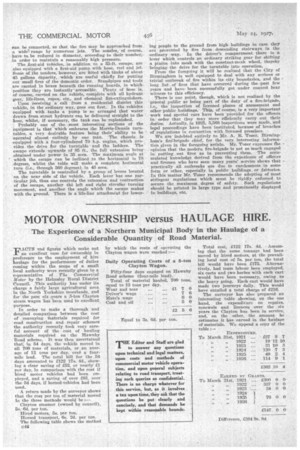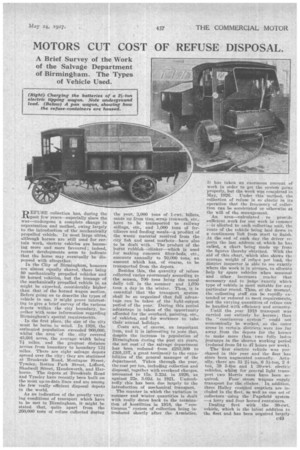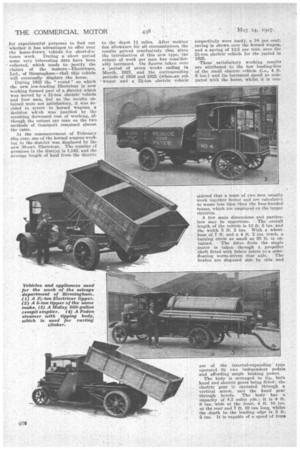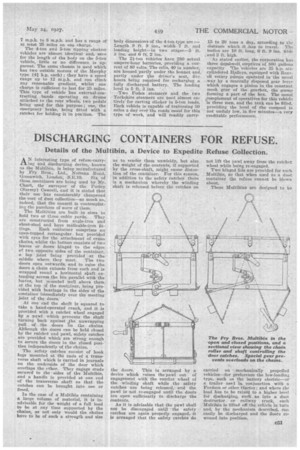MOTOR OWNERSHIP versus HAULAGE HIRE.
Page 106

Page 107

Page 108

Page 109

If you've noticed an error in this article please click here to report it so we can fix it.
The Experience of a Northern Municipal Body in the Haulage of a Considerable Quantity of Road Material.
MIACTS and figures which make out an excellent case for ownership in preference to the employment of hire haulage for the performance of duties coming within the scope of a small local authority were recently given to a representative of The Commercial Motor by the Helmsley Rural District Council. This authority has under its charge a fairly large agricultural area in the North Yorkshire moorlands, and for the past six .years a 5-ton Clayton steam wagon has been used to excellent purpose.
In order to make a thorough and detailed comparison between the cost of conveying Materials required for road construction and repair schemes the authority recently took very careful account of the cost of hauling materials required on the Hawnby Road scheme. It was then ascertained that, in 54 days, the vehicle moved in all 700 tons of materials, or an average of 13 tons per day, ovei a fourmile lead. The total bill for the 54 days amounted to 1122 17s. 4d., showing a clear saving of £52, or nearly £1 per day, in comparison with the cost if hired motor vehicles had been employed, and a saving of over £93. over the 54 days, if horsed-vehicles had been used.
A return made by the surveyor shows that the cost per ton of material moved In the three methods would be : Clayton steamer (owned by council), 2s. 6d. per ton.
Hired motors, 5s. per ton.
Horsed transport, Gs. 2d. per ton. The following table shows the method c42 by which the costs of operating the Clayton wagon were reached:— Total cost, £122 1.7s. 4d. Assuming that the same tonnage had been moved by hired motors, at the prevailing local cost of Sc. per ton, the total bill would have been £175. Alternatively, had team labour been employed, six carts and two holies with each cart would have been necessary, owing to the heavy going. Each cart would have made two journeys daily. This would have entailed a total charge of £216.
The surveyor has also prepared an interesting table showing, on the one hand, the expenditure on repairs, renewals and licences over the six years the Clayton has been in service, and, on the other, the amount he estimates it has earned in the haulage of materials. We append a copy of the table :—
REFUSE collection has, during the past few years—especially since the war—undergone a complete change in organization and method, owing largely to the introduction of the mechanically propelled vehicle. In most large cities, although horses are still used for certain work, electric vehicles are becoming more and more favoured; indeed, recent developments seem to indicate that the horse may eventually be dispensed with altogether.
In the City of Birmingham, honours are almost equally shared, there being 80 mechanically propelled vehicles and 80 horsed vehicles, but the tonnage of the mechanically propelled vehicle iâ, as might be expected, considerably higher than that of the horsed wagon section. Before going on to describe the types of vehicle in use, it might prove interesting to give a brief survey of the various depots within the city boundary, together with some information regarding Birmingham's special requirements.
In the first place, the size of the city mast be borne in mind. In. 1926, the estimated population exceeded 960,000, whilst the area of the city covered 43,601 acres, the average width being 71 miles, and the greatest distance across from boundary to boundary 121 miles. There are eight salvage depots spread over the. city ; they are stationed at Brookvale Road, Montague Street, Tyseley,Rotten Park Street, Lifford, Shadwell Street, Handsworth, and Harborne. The depots at Brookvale Road and Tyseley have recently been built on the most up-to-date lines and are among the few really efficient disposal depots in the world.
As an indication of the greatly varying conditions of transport which have to he met in Birmingham, it might be stated that, quite apart from the 260,000 tons of refuse collected during the year, 3,000 tons of 1-ewt. billets, made up from tins, scrap ironwork, etc., have to be transported to railway sidings, etc., and 1,000 tons of fertilizers and feeding meals—a product of the waste material received from the city fish and meat markets—have also to be dealt with. The product of the burnt rubbish—clinker—which is used for making concrete filter-beds, etc., amounts annually to 70,000 tons, an amount which has, of course, to be transported from the depots.
Besides this, the quantity of refuse collected varies enormously according to the season, 700 tons being the usual daily toll in the summer and 1,050 tons a day in the winter. Thus, it is essential that the transport system shall be so organized that full advantage can be taken of the light-output period of the year. During this period advantage is taken of the opportunity afforded for the overhaul, painting, etc., of vehicles, and for workmen to take their annual holidays.
Costs are, of course, an important item, and it is interesting to note that, despite the increase in .population of Birmingham during the past six years, the net cost cf the salvage department has been reduced from £283,309 to £201,317, a great testimony to the capabilities of the general manager of the department. Taken through the year, the cost per ton, including collection and disposal, together with overhead charges, amounted to 155. 5.23d. in 1926, as against 22s. 3.02d. in 1921. Undoubtedly this has been due largely to the introduction of mechanical transport.
The manner in which the variation in summer and winter quantities is dealt with really dates back to the termination of hostilities in 1918, the " continuous " system of collection being introduoed shortly after the Armistice. It has taken an enormous amount of work in order to get the system going properly, but the work was completed in May, 1926. Under this method, the collection of refuse is so elastic in its operation that the frequency of collection can be accelerated or otherwise at the will of the management.
An area—calculated to provide sufficient _work for one week in summer --is allotted to each collecting unit, the route of the vehicle being laid down in a continuous lint from start to finish. At the end of each day the driver reports the last address at which he has called, a chart being made up from the figures thereby obtained. With the aid of this chart, which also shows the average weight of refase per load, the district inspector is able to see exactly where the work is in arrears, to allocate help by spare vehicles when seasonal and other increases render that necessary and to judge exactly which type of vehicle is most suitable for any particular round. Thus, at the moment, the collecting staff can be rapidly extended or reduced to meet requirements, and the varying quantities of refuse can be handled with efficiency and economy.
Until the year 1918 transport was carried out entirely by. horses; then the "continuous system" could not economically be worked, as the outer areas in certain districts were too far away from the depots for the horses to make more than two fully laden journeys in the shorter working period (reduced from 54 to 47 hours per week).
The first electric vehicle was pur chased in this year And the fleet has since been augmented annually. Actually, there are 31 21-ton, 6 31-ton, 3 4ton, 39 5-ton and 1 30-cwt. electric vehicles, whilst for general light transport two Morris vans have been ac quired. Four steam wagons supply transport for the. clinker. In addition, three Halley cessnool emptiers are included in the fleet, as well as one set of collectors using the Pagefield system —a lorry and four horsed containers.
Dealing first with the 30-cwt. vehicle, which is the latest addition to the fleet and has been acquired largely for experimental purposes to find out whether it has advantages to offer over the horse-drawn vehicle for short-distance work. During a short period some very interesting data have been collected, which tends to jnstify the claims of the makers—Eleetricars, Ltd., of Birmingham—that this vehicle will eventually displace the horse.
During 1925 the " round " on which the new low-loading Electricar is now working formed-part of a district which was served by a 2i-ton electric vehicle and four men, but as the results obtained were not satisfactory, it was decided to revert to horsed wagons, a decision which was justified by the resulting decreased cost of working, although the output per man on the two methods of transport remained almost the same.
At the commencement of February this year, one of the horsed wagons working in the district was displaced by the new 30-cwt. Electriear. The number ef premises in the district is 1,142, and the average length of haul from the district to the depot 1i miles. After making due allowance for all circumstances, the results proved conclusively, that since the introduction of this new type, the output of work per man has considerably increased. On figures taken over a period of seven weeks ending in March, 1927, and the corresponding periods of 1926 and 1925 (whem.an ash wagon and a 24-ton electric vehicle respectively were used), a 10 per cent, saving is shown over the horsed wagon, and a saving of 13.5 per cent. over the 2I-ton electric vehicle for the period in 1925.
These satisfactory working results are attributed to the low loading-line of the small electric vehicle (i.e., 4 ft. 8 ins.) and its increased speed as compered with the horse, whilst it is con sidered that a team of two men usually work together better and are calculated to waste less time than the four-handed teams, which are employed on the larger eleetrics.
A few main dimensions and particu lars may be opportune. The overall length of the vehicle is 13 ft. 5 ins, and the width 5 ft. 2 ins. With a wheelbase of 7 ft. and a 4 ft. 2 ins, track, a turning circle as small as 26 ft. is obtained. • The drive from the single motor is taken through a propeller shaft fitted with fabric joints to a semi Boating worm-driven rear axle. The brakes are disposed side by sidv and are of the internal-expanding type operated 117 two independent pedals and affording ample braking power.
The body is arranged to tip, both hand and electric gears being fitted ; the electric gear is operated through a vertical screw, and the hand gear through bevels. The body has a capacity of 9.3 cubic yds. ; it is 4 ft. 8 ins, wide at the front, 4 ft. 10 ins. at the rear and 7 ft. 10 ins, long, whilst the depth to the loading edge is 2 ft. Sins. It is capable of a speed of from 7 m.p.h. to 8 m.p.h. and has a range of.' at least 25 miles on one charge.
The 4-ton and 5-ton tipping electric Vehicles are almost identical and, save for the length of the body on the 5-ton vehicle, little or no difference is ape parent. The same chassis is used which has two outside motors of the Murphy type (4i h.'s. each) ; they have a speed range up to 12 m.p.h. and can climb any reasonable gradient, whilst one charge is sufficient to last for 25 miles. This type of vehicle has external-contracting bands operating on drums attached to the rear wheels, two pedals being used for this purpose ; one, the emergency brake, being fitted with a ratchet for holding it in position. The body dimensions of the 4-ton typo are:—
Length .ft. 9 ins., width 7 ft. and loading height—in two stages-5 ft. 3 ins. and 6 ft 2 ins.
The 2i-ton vehicles have 280 actual ampere-hour batteries, providing a current of 80 volts. The cells, 40 in number, are housed partly under the bonnet and, partly under the driver's seat, fivehours being required for recharging a fully discharged battery. The loading level is 5 ft. 3 ins. • .
Two Foden steamers and the two Yorkshire steamers are used almost entirely for carting clinker in 5-ton loads. Each vehicle i,s capable of traversing 80 miles a day over tbe roads usual for this type of work, and will readily carryt 15 to 20 tons a day, according to the distance which it leis to travel. The bodies are 10 ft. long, 6 ft. 9 ins. Wide and 2 ft. high.
As stated earlier, the corporation has three dumbwell emptiers of SOO gallons capacity The vehicles are 35h.p. sixcylindered Ilalleys, equipped with Reeve!' rotary pumps operated in the usual way by a centrally disposed gear lever which. engages a pinion in the constant mesh -gear of the gearbox, the Tuns') forming a part of the box. The usual. _complement of operatives for this vehicle is three men, and the tank can be filled, providing the level of the cesspool is not unduly low, in five minutes—a very creditable performance.




















































































































































































